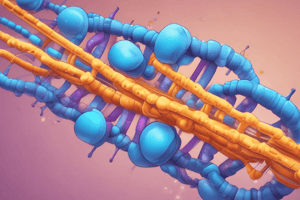Podcast
Questions and Answers
What is the role of telomeres in preventing chromosomal instability?
What is the role of telomeres in preventing chromosomal instability?
- Facilitating chromosome condensation
- Promoting chromosomal recombination
- Ensuring proper chromosome segregation
- Protecting the ends of chromosomes from fraying and sticking to neighboring chromosomes (correct)
Which post-translational modification of histone proteins helps in chromosome condensation?
Which post-translational modification of histone proteins helps in chromosome condensation?
- Glycosylation
- Ubiquitination
- Acetylation (correct)
- Sumoylation
What is the primary composition of chromatin?
What is the primary composition of chromatin?
- DNA wrapped around histone proteins (correct)
- Histone proteins wrapped around DNA
- Free-floating histones
- Double-stranded RNA
What is the function of the kinetochore during cell division?
What is the function of the kinetochore during cell division?
How long is the DNA strand when stretched out in a single cell nucleus?
How long is the DNA strand when stretched out in a single cell nucleus?
How do telomeres act as a timer for cell replication?
How do telomeres act as a timer for cell replication?
Which proteins make up the core octamer of histones in a nucleosome?
Which proteins make up the core octamer of histones in a nucleosome?
Which proteins are found at centromeres and are crucial for proper chromosome segregation?
Which proteins are found at centromeres and are crucial for proper chromosome segregation?
Which process is chromosome condensation critical for?
Which process is chromosome condensation critical for?
In what state do cells enter when telomeres reach a critical length?
In what state do cells enter when telomeres reach a critical length?
What are the specialized structures that maintain chromosome stability?
What are the specialized structures that maintain chromosome stability?
In which cellular process is chromosome condensation essential for segregating chromosomes accurately?
In which cellular process is chromosome condensation essential for segregating chromosomes accurately?
Flashcards are hidden until you start studying
Study Notes
Understanding Chromosome Organization
Chromosomes, the structural units of our genetic material, are intricately organized to ensure the efficient packaging, storage, and transmission of genetic information. Their organization includes various aspects, such as the arrangement of DNA, the role of proteins, and the specialized structures that maintain chromosome stability. Let's explore each of these subtopics:
Chromatin Structure
Chromatin, the complex of DNA and proteins involved in chromosome organization, is primarily composed of DNA wrapped around histone proteins to form nucleosomes. Nucleosomes are the basic structural units of chromatin, and they are essential for the folding and compaction of the DNA strand, which is approximately 2 meters long when stretched out in a single cell nucleus.
Nucleosome Organization
Nucleosomes consist of a core octamer of histone proteins (two copies each of histones H2A, H2B, H3, and H4) wrapped by approximately 146 base pairs of DNA. Chromatin is further organized into higher-order structures, such as 30-nanometer fibers and chromatin loops, which help condense and arrange the DNA within the cell nucleus.
Chromosome Condensation
The condensation of chromosomes is a critical process during cell division, particularly during mitosis and meiosis. This condensation is essential for accurately segregating the chromosomes between daughter cells, without disrupting the genetic information. Chromosome condensation is facilitated by the modification of histone proteins, which undergo various post-translational modifications, such as acetylation, methylation, and phosphorylation.
Telomere Structure
Telomeres, the protective caps on the ends of chromosomes, consist of repetitive DNA sequences and associated proteins. They play a crucial role in preventing chromosomal ends from fraying and sticking to neighboring chromosomes, which could lead to genome instability. Telomeres also act as a timer for cell replication, as they gradually shorten with each cell division. Once telomeres reach a critical length, cells enter a state of senescence or apoptosis.
Centromere Function
Centromeres, located approximately halfway along the length of each chromosome, are essential regions for ensuring proper chromosome segregation during cell division. They are composed of repetitive DNA sequences and specific proteins, such as cohesins and kinetochore proteins. The kinetochore, a protein complex that forms on the centromere, serves as a docking site for microtubules from the spindle, which pull the chromosomes apart to equal distribution between daughter cells during cell division.
Understanding chromosome organization is essential for grasping the intricacies of genetics, cell division, and development, and it has practical applications in understanding human disease and the development of new therapies. By studying the structure, organization, and function of chromosomes, researchers can gain insights into the underlying principles of cellular organization and function.
Studying That Suits You
Use AI to generate personalized quizzes and flashcards to suit your learning preferences.



